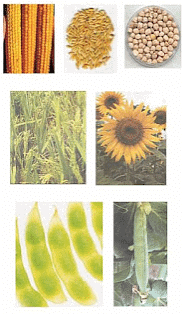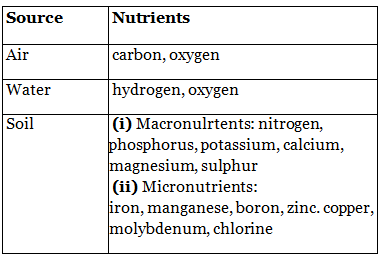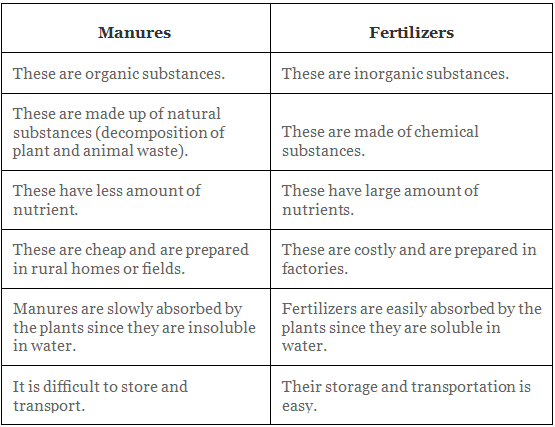Improvement in Food Resources Summary Class 9 Science Chapter 12
Introduction
- All living organisms need food for health, growth and development.
- Food provides nutrients like carbohydrates, fats, protein, vitamins and minerals.
- Both plants and animals are major sources of food.
- India has a high population of more than one billion and is still growing.
- To feed this growing population we need more than a quarter of a billion tonnes of grain per year.
- This can be done by farming on more land but India is already intensively cultivated. Hence, it is necessary to increase the efficiency of production for both crops and livestock.
Green Revolution
- Green revolution is a programme introduced in many countries to increase food production by use of modern technology, proper irrigation, improved seeds etc.

White Revolution
- White revolution is a programme in India to increase production of milk in India. This programme made India self-sufficient in production of milk.
Improvement in Crop Yields
Types of Crops:
- Cereals: They include crops like wheat, rice, maize, barley etc. They provide us carbohydrates.
- Seeds: Not all seeds of plants are edible like seeds of apple or cherries. Edible seeds include cereals, pulses, oil seeds and nuts. They provide us fats.
- Pulses: They include legumes such as gram, pea, black gram, green gram, lentil. They provide us proteins.
- Vegetables, spices and fruits: They provide us vitamins & minerals. They include apple, mango, cherry, banana, water-melon etc.
- Vegetables like spinach, leafy vegetables, carrot etc.
- Spices like chilly, black pepper, fodder crops, oats etc.
Crop Season
- Different crops require different conditions (temperature, moisture, etc.), different photo-periods (duration of sunlight) for their growth and completing life cycle.
The two types of crops seasons are:
- Kharif Season: These crops grow during rainy season (June to October).
Example: black gram, green gram, pigeon pea, rice, paddy, soyabean. - Rabi Season: These crops are grown during November to April. Rabi crops are known as winter crops. Example: wheat, gram, peas, mustard, linseed etc.
Approaches which enhance the crop yield are as following:
- Crop variety improvement
- Crop production improvement
- Crop protection improvement
Crop Variety Improvement
- Factors by which variety improvement can be done are:
- Good and healthy seeds
- Hybridization: It is the process of crossing between two or more genetically dissimilar plants to produce a new variety with good properties of both the crops.
Properties to be possessed by improved seeds
- Higher yield: To increase the productivity of the crop per acre.
- Improved quality: Quality of crop products vary from crop to crop.
- Biotic & Abiotic resistances: Crop production reduces due to biotic and abiotic factors. Varieties resistant to these factors can improve crop production.
- Wider adaptability: Crops which can grow in different conditions, will help in setting high production.
- Desired agronomic traits: Crops which contain desired agronomic traits (height, branching, leafs), sets high production.
Crop Production Improvement
- It involves different practices carried out by farmers to achieve higher standards of crop production.
The different practices are:
- Nutrient management
- Irrigation
- Cropping patterns
Nutrient Management: Like other organisms, plants also require some elements for their growth. These elements are called nutrients.
Manure and Fertilizers
Manure
To increase the yield, the soil can be enriched by supplying nutrients in the form of manure and fertilizers.
- Manure is a source of organic matter.
- It supplies small quantities of nutrient to the soil.
- It is prepared by the decomposition of animal excreta and plant waste.
Various forms of Manures
- Compost: The process in which animal excreta (like cow dung), kitchen waste, plant remains, waste food, sewage waste etc. are decomposed in pits is known as composting.
- Vermicompost: Compost prepared by using earthworms to hasten the process of decomposition of plants and animals refuse is called vermicompost.
- Green manure: Some plants like sun hemp, guar etc. are grown and after sometime mulched by ploughing in the field.
These green plants turn into green manures. They are rich in nitrogen and phosphorus.
Fertilizers
- Fertilizers are prepared in factories. They are made up of chemical substances.
- They have large amount of nutrients like nitrogen, phosphorus and potassium.
- Fertilizers are easily absorbed by the plants since they are soluble in water. It is costly.
Difference Between Manures and Fertilizers

Irrigation
- The process of supplying water to the crop plants is called irrigation.
Methods of Irrigation
- Two types of wells:
- Dug wells: In dug wells, water is collected by bullock-operated devices or by pumps.
- Tube wells: It makes very deep underground water available for irrigation. Motor pump is used to lift water.
- Canals: These get water from large rivers.
- River lift system: In this system, water is directly taken from rivers through pumps. This system is useful for irrigation in areas close to river.
- Tanks: These are small storage reservoirs.
- Rain water harvesting: Rain water harvesting is a accumulation of water in tanks for later use. This also prevents soil erosion.
Crop Patterns
- Different patterns are used to maximize the production from crop field.
The different patterns are:
- Mixed cropping
- Inter cropping
- Crop rotation
Mixed cropping: Growing two or more than two crops together on the same piece of land is called mixed cropping.
Examples: wheat and gram, wheat and mustard, groundnut and sunflower.
Inter cropping: Two or more crops are grown on the same field in a definite pattern. Few rows of one followed by few rows of the other.
Examples: Soyabean+maize, Finger nullet (Bajra)+Cow pea (lobia)
Crop rotation: Crop rotation is policy of growing different crops one after another on the same field.
If some crop is grown again and again on the same field, same nutrients are extracted from soil again and again. So we should choose different crops so that all nutrients of soil are used.
Advantages of crop rotation:
- Soil fertility is maintained.
- It controls pests and weeds.
- Several crops can be grown in succession with only one soil preparation.
Crop Protection Improvement
- To protect crops against diseases caused organisms and other harming factors is called crop protection.
Methods used to control the problems:
- Pest control during growth
- Storage of grains
Pest Control During Growth
- Pest is any destructive organism which can destroy or harm crops or products obtained from them.
Types of pests:
- Weeds: Unwanted plants in the cultivated field. Example: xanthium.
- Insects: Insects can harm plants in following ways :
- They cut the root, stem and leaf.
- They suck the cell sap from various parts of the plant.
- Pathogens: Any organism such as bacteria, fungi and viruses which cause diseases in plants are called pathogens.
- They are transmitted through air, water, soil.
Storage of Grains
- For getting seasonal foods throughout the year, they are stored in safe storage. But during storage of grains, they can be destroyed and wasted by various means.
- Biotic problem: Due to living organisms like insects, birds, mites, bacteria, fungi.
- Abiotic problem: Due to non-living factors such as moisture, inappropriate temperature etc.
- These factors affect quality degradation, loss in weight, change in colour, poor germinability.
Organic Farming
- Use of fertilizers and pesticides has their own disadvantages. They cause pollution, damage soil fertility in long run. Grains, fruits, vegetables obtained may contain harmful chemical in small amount.
- Organic farming is a farming system with no or very little use of chemicals like fertilizers and pesticides.
Ways to protect food grains before they are stored for future use:
- Drying: The food grains should be properly dried in the sun.
- Maintenance of hygiene: The grains must not contain insects. The godowns should be cleaned well. The cracks in the roof and on the walls and floor should be sealed completely.
- Fumigation: Godowns and stores should be properly sprayed with fumigants. Specially, the seeds should be treated with insecticides and fungicides.
- Storage devices: Cleaned and dried grains should be stored in gunny bags or other proper bags.
Airtight, moisture-resistant and temperature resistant storage devices have been developed by various organizations.
Animal Husbandry
Animal husbandry is a scientific management of domestic animals in an efficient manner to obtain food and other useful products from them.
Purpose of cattle farming:
- For getting milk
- Ploughing fields
- Bull cart for transportation
Types of cattle:
- Cow (Bos indicus)
- Buffalo (Bos bubalis)
Milch animals: These includes milk producing animals (female cattle).
Draught animals: Those animals which do not produce milk and are used for agricultural work.
Lactation period: The period of milk production between birth of a young one and the next pregnancy is called lactation period.
Care of Cattle:
Cleanliness
- Roofed shelter with good ventilation for protection from rain, heat and cold.
- Regular brushing of skin of cattle.
- Sloping floor for shelter for avoiding water-logging.
Food
- Roughage mainly containing fibre
- Concentrates containing proteins
- Food containing micro nutrients (vitamins and minerals) for enhanced milk production.
Diseases: Diseases can cause death and reduce milk production.
- Parasites are small organisms living inside or outside the body of another organism (host). They derive food from the body of host.
- External parasites on skin of cattle cause skin diseases.
- Internal parasites like worms cause stomach and intestine problems and flukes cause liver problems.
- Bacteria, virus cause infectious diseases (diseases that can be easily transmitted from one to another).
Poultry Farming: Poultry farming is done for eggs and meat. They both provide protein to our diet.
Broilers: Birds grown for obtaining meat are called broilers. They can be used after 6-8 weeks from their birth.
Layers: Birds grown for obtaining egg are called layers. They can be used after 20 weeks when sexual maturity has been attempt to lay eggs.
- Most of the broilers and layers are cross-breed.
- Breeding is done to enhance following properties in hens like:
- More and better quality chicks.
- Low maintenance.
- Breeding is done to produce dwarf broilers (meat-giving birds). Feeding cost is the biggest expense in poultry farms.
- Dwarf broilers need less food and can reduce cost by 30%. Also, they can tolerate more heat.
Fish Production
Fish production is a great source of protein to our diet.
Fish production is of two types:
- Finned fish production/True fish production: Production and management of cartilaginous and bony fishes such as pomphret, tuna,bcod, catla, prawns, rohu etc.
- Unfinned fish production: Production of shell-fish such as prawns, mollusks.
Fishing are of two types on the mode of obtaining fishes:
- Capture fishing: Naturally living fishes in various water bodies are captured.
- Culture fishing: Fishes of desired variety are cultivated in confined areas with utmost care to get maximum yield. This is also called aquaculture.
Aquaculture can be done in oceans, rivers, lakes, ponds etc. When it is done in oceans, it is called mariculture.
Marine fishing: Marine fishing includes fish production in ponds, rivers, reservoirs.
- Popular marine fishes includes pomphret, tuna, sardines, Bombay duck.
- Some costly fishes found in sea like nullets, prawns, seaweed, oysters.
- Using satellites, regions of high fish population in sea can be found. Echo-sounders are also used.
Inland fishing: It includes fish production in fresh water (for example ponds, rivers, lakes, reservoirs) and brackish water (for example estuaries).
Composite Fish Culture
- 5 to 6 varieties in a single fish pond.
- They are selected so that they do not compete for food. They should have different food requirement.
Example of Fish:
- Catla: Feeds in the upper part of water.
- Rohu: Feeds in middle part of water.
- Mrigals, common carps: Feeds at bottom.
- Advantage of Fishing: More yield.
- Problems of Fishing: Many fishes lay eggs during monsoons only, due to which number of fishes will not grow fast. So hormonal stimulation is used.
Using this, fishes can be made to reproduce any time.
Bee-keeping
- It is the practice of keeping, caring & management of honeybees on a large scale for obtaining honey and wax.
- Many farmers use bee-keeping for additional small income. Also, there are big farms called apiaries/bee farms.
Apiary: The setting up of a number of bee hives in desirable location in a systematic manner that allows maximum pollen and nectar collection.
- Some common Indian varieties of bees include apis carana indica (Indian bee), dorsata (rock bee), floral (little bee).
- One Italian variety mellifera is also used in India for commercial large scale production.
Advantages of Italian variety Melifera:
- High honey collection capacity.
- They reproduce fast.
- They sting less.
- They stay in a bee hive for long.
Honey
- It is a dense sweet liquid.
- It is used in medicines. It is used as sugar.
- It is used as a source of energy.
Pasturage
- Pasturage is the availability of flowers to the bees for nectar and pollen collection.
- Pasturage of flora is the type of crop, flower or other plants from which bee collects nectar and pollen to produce honey.
- It affects the quality and quantity of honey because different flora produce nectar and pollen of different types such as almond honey of Kashmir is very tasty.
|
31 videos|126 docs|52 tests
|
FAQs on Improvement in Food Resources Summary Class 9 Science Chapter 12
| 1. What are the factors that contribute to the improvement in food resources? |  |
| 2. How can modern machinery and tools help in improving food resources? |  |
| 3. What role does irrigation play in improving food resources? |  |
| 4. How do fertilizers and pesticides contribute to the improvement in food resources? |  |
| 5. What are the benefits of adopting scientific practices in agriculture? |  |





















